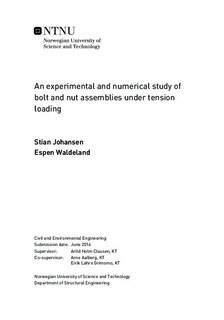An experimental and numerical study of bolt and nut assemblies under tension loading
Master thesis
Permanent lenke
http://hdl.handle.net/11250/2614895Utgivelsesdato
2016Metadata
Vis full innførselSamlinger
Sammendrag
The purpose of this master thesis is to investigate how the nut position affects the failure mode of single tensile loaded bolts under quasi-static conditions. A ductile bolt fracture is preferable from an engineering perspective, as opposed to thread stripping which is typically regarded as a brittle fracture mode. It is advantageous with large deformation of bolts in extreme load cases, because this is easier to detect upon inspection.
Various partially threaded bolt and nut types were investigated in experimental tests. Different nut positions were tested for a range of bolt and nut configurations. Experimental tests showed that thread stripping was more likely to occur when the nut was positioned close to the unthreaded part of the bolt. It was also registered that the use of a high nut or two regular nuts resulted in bolt fracture regardless of the nut position. One Vickers hardness test of each bolt and nut type were also performed.
In addition to experimental testing, finite element models were used to investigate how material and geometrical factors influenced the failure modes. Another objective was to investigate if a 3D model including the helical shape of the threads gave better prediction of the failure modes, compared with an axisymmtric model. All models were able to predict both bolt fracture and thread stripping with reasonable accuracy.
Finite element modeling revealed that material and geometrical factors highly influenced the failure mode of tensile loaded bolts. The 3D helix model was more accurate in predicting the correct physical behaviour because of more accurate geometry, however with a massive increase in computational cost. Anyhow, the axisymmetric model gave reasonable results with only a fraction of the computational cost
